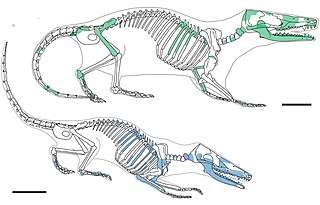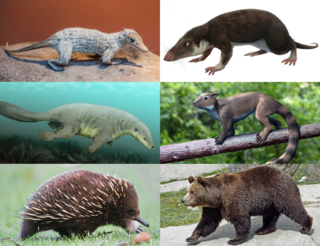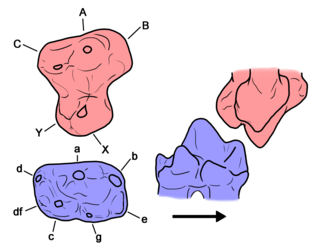
Castorocauda is an extinct, semi-aquatic, superficially otter-like genus of docodont mammaliaforms with one species, C. lutrasimilis. It is part of the Yanliao Biota, found in the Daohugou Beds of Inner Mongolia, China dating to the Middle to Late Jurassic. It was part of an explosive Middle Jurassic radiation of Mammaliaformes moving into diverse habitats and niches. Its discovery in 2006, along with the discovery of other unusual mammaliaforms, disproves the previous hypothesis of Mammaliaformes remaining evolutionarily stagnant until the extinction of the non-avian dinosaurs.

Docodonta is an order of extinct Mesozoic mammaliaforms. They were among the most common mammaliaforms of their time, persisting from the Middle Jurassic to the Early Cretaceous across the continent of Laurasia. They are distinguished from other early mammaliaforms by their relatively complex molar teeth. Docodont teeth have been described as "pseudotribosphenic": a cusp on the inner half of the upper molar grinds into a basin on the front half of the lower molar, like a mortar-and-pestle. This is a case of convergent evolution with the tribosphenic teeth of therian mammals. There is much uncertainty for how docodont teeth developed from their simpler ancestors. Their closest relatives may have been certain Triassic "symmetrodonts", namely Woutersia, Delsatia.

Mammaliaformes is a clade that contains the crown group mammals and their closest extinct relatives; the group radiated from earlier probainognathian cynodonts. It is defined as the clade originating from the most recent common ancestor of Morganucodonta and the crown group mammals; the latter is the clade originating with the most recent common ancestor of extant Monotremata, Marsupialia, and Placentalia. Besides Morganucodonta and the crown group mammals, Mammaliaformes includes Docodonta and Hadrocodium.

Docodon is an extinct docodont mammaliaform from the Late Jurassic of western North America. It was the first docodont to be named.

Gobiconodon is an extinct genus of carnivorous mammals belonging to the family Gobiconodontidae. Undisputed records of Gobiconodon are restricted to the Early Cretaceous of Asia and North America, but isolated teeth attributed to the genus have also been described from formations in England and Morocco dating as far back as the Middle Jurassic. Species of Gobiconodon varied considerably in size, with G. ostromi, one of the larger species, being around the size of a modern Virginia opossum. Like other gobiconodontids, it possessed several speciations towards carnivory, such as shearing molariform teeth, large canine-like incisors and powerful jaw and forelimb musculature, indicating that it probably fed on vertebrate prey. Unusually among predatory mammals and other eutriconodonts, the lower canines were vestigial, with the first lower incisor pair having become massive and canine-like. Like the larger Repenomamus there might be some evidence of scavenging.

Dryolestidae is an extinct family of Mesozoic mammals, known from the Middle Jurassic to the Early Cretaceous of the North Hemisphere. The oldest known member, Anthracolestes, is known from the Middle Jurassic Itat Formation of Western Siberia, but most other representatives are known from the Late Jurassic of North America and the Late Jurassic and Early Cretaceous of Europe. Most members are only known from isolated teeth and jaw fragments. Like many other groups of early mammals, they are thought to have been insectivores. They are generally classified in Cladotheria, meaning that they are considered to be more closely related to marsupials and placentals than to monotremes. They are placed as part of the broader Dryolestida, which also includes the Paurodontidae, and also sometimes the South American-Antarctic Meridiolestida, which are often considered unrelated cladotherians. Dryolestidae taxon is not based on a phylogenetic definition, but instead on the possession of unequal roots for the molars of the lower jaw. Additionally, the clade is distinguished by hypsodonty in lower molars, and uneven labio-lingual height for the alveolar borders of the dentary.

Shuotheriidae is a small family of Jurassic mammaliaforms whose remains are found in China, Great Britain and possibly Russia. They have been proposed to be close relatives of Australosphenida, together forming the clade Yinotheria. However, some studies suggest shuotheres are closer to therians than to monotremes, or that australosphenidans and therians are more closely related to each other than either are to shuotheres, with a 2024 study suggesting that shuotheriids were closely related to Docodonta outside of the Mammalia crown group.

Triconodontidae is an extinct family of small, carnivorous mammals belonging to the order Eutriconodonta, endemic to what would become Asia, Europe, North America and probably also Africa and South America during the Jurassic through Cretaceous periods at least from 190–66 mya.
The Itat Formation is a geologic formation in western Siberia. It was deposited in the Bajocian to Bathonian ages of the Middle Jurassic. Dinosaur remains are among the fossils that have been recovered from the formation, including the proceratosaurid Kileskus, as well as fish, amphibians, mammals and many other vertebrates. The formation is noted for bearing significant coal reserves, with large open pit coal mines extracting lignite from the unit currently in operation.
Paritatodon is an extinct mammaliaform which existed in Kyrgyzstan and England during the Jurassic period. It was originally the holotype specimen of Shuotherium kermacki, but Martin and Averianov (2010) argued that it resembled the genus Itatodon (Docodonta) and so renamed it Paritatodon.
Hutegotherium is an extinct genus of tegotheriid docodont known from partial remains found in Middle Jurassic Itat Formation of Krasnoyarsk Krai, Russia. It was first named by Averianov, A. A.; Lopatin, A. V.; Krasnolutskii, S. A.; and Ivantsov, S. V. in 2010 and the type species is Hutegotherium yaomingi.

Megaconus is an extinct genus of allotherian mammal from the Middle Jurassic Tiaojishan Formation of Inner Mongolia, China. The type and only species, Megaconus mammaliaformis was first described in the journal Nature in 2013. Megaconus is thought to have been a herbivore that lived on the ground, having a similar posture to modern-day armadillos and rock hyraxes. Megaconus was in its initial description found to be member of a group called Haramiyida. A phylogenetic analysis published along its description suggested that haramiyidans originated before the appearance of true mammals, but in contrast, the later description of the haramiyidan Arboroharamiya in the same issue of Nature indicated that haramyidans were true mammals. If haramiyidans are not mammals, Megaconus would be one of the most basal ("primitive") mammaliaforms to possess fur, and an indicator that fur evolved in the ancestors of mammals and not the mammals themselves. However, later studies cast doubt on the euharamiyidan intrepretation, instead finding it to be a basal allotherian mammal.

Yinotheria is a proposed basal subclass clade of crown mammals uniting the Shuotheriidae, an extinct group of mammals from the Jurassic of Eurasia, with Australosphenida, a group of mammals known from the Jurassic to Cretaceous of Gondwana, which possibly include living monotremes. Today, there are only five surviving species of monotremes which live in Australia and New Guinea, consisting of the platypus and four species of echidna. Fossils of yinotheres have been found in Britain, China, Russia, Madagascar and Argentina. Contrary to other known crown mammals, they retained postdentary bones as shown by the presence of a postdentary trough. The extant members (monotremes) developed the mammalian middle ear independently.

Haldanodon is an extinct docodont mammaliaform which lived in the Upper Jurassic. Its fossil remains have been found in Portugal, in the well-known fossil locality of Guimarota, which is in the Alcobaça Formation. It may have been a semi-aquatic burrowing insectivore, similar in habits to desmans and the platypus. Several specimens are known, include a partial skeleton and well-preserved skulls.
The Ilek Formation is a Lower Cretaceous geologic formation in Western Siberia. Many different fossils have been recovered from the formation. It overlies the Late Jurassic Tyazhin Formation and underlies the Albian Kiya Formation.
Tashkumyrodon is an extinct mammaliaform from the Middle Jurassic (Callovian) Balabansai Formation of Kyrgyzstan It is named after the town of Tash-Kömür, near where the original specimen was found. It belongs to the order Docodonta and is closely related to Sibirotherium and Tegotherium. There is only one species currently known, Tashkumyrodon desideratus.

Borealestes is a genus of docodontan from the Middle Jurassic of Britain, first discovered on the Isle of Skye near the village of Elgol. It was the earliest mammaliaform from the Mesozoic found and named in Scotland. A second species and was later found in other Middle Jurassic sites in England, but is now shown to be a different genus. A new species, B. cuillinensis was named in 2021, also from Skye.
Simpsonodon is an extinct genus of docodontan mammaliaform known from the Middle Jurassic of England, Kyrgyzstan and Russia. The type species S. oxfordensis was described from the Kirtlington Mammal Bed and Watton Cliff in the Forest Marble Formation of England. It was named after George Gaylord Simpson, a pioneering mammalologist and contributor to the Modern Evolutionary Synthesis. A second species S. sibiricus is known from the Itat Formation of Russia, and indeterminate species of the genus are also known from the Balabansai Formation in Kyrgyzstan
Dobunnodon its an extinct genus of docodont from the Middle Jurassic (Bathonian) Forest Marble Formation of England, first discovered in Oxfordshire near the village of Kirtlington. The type species, D. mussettae, was originally named as a species of Borealestes in 2003.
Sibirotherium is an extinct genus of docodont mammaliaform. It is known from only a single named species, Sibirotherium rossicum, known from jaw fragments and teeth found in the Early Cretaceous (Aptian) aged Ilek Formation in western Siberia, alongside Khorotherium also from Siberia, it is one of the youngest docodonts.














